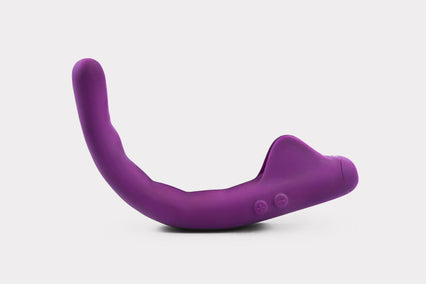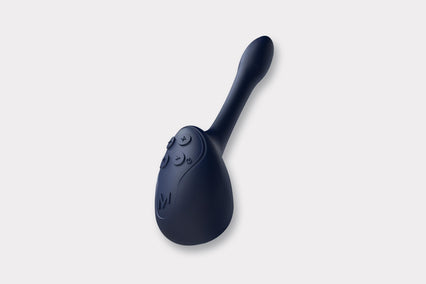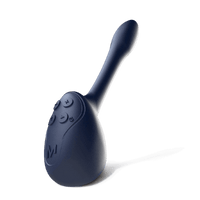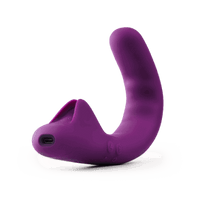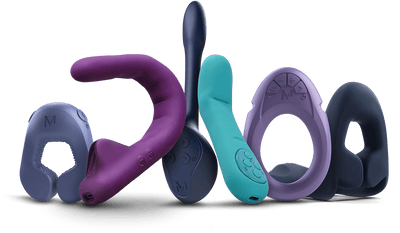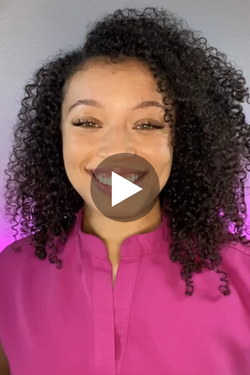Last Updated: 1st February 2024
When was the last time you had an orgasm with your partner? When you have partnered sex, do you tend to orgasm more – or less – frequently than they do? These questions are key to unlocking whether there’s an ‘orgasm gap’ in your relationship. While we hope there’s orgasm equality in your relationships, studies have shown that in heterosexual relationships, men tend to have orgasms more frequently than their female partners – a lot more.
What is the orgasm gap?
The statistical difference between the frequency and number of orgasms that heterosexual men and heterosexual women have is known as the orgasm gap. This disparity is often referred to as the orgasm gap, orgasmic gap, or pleasure gap. The ‘orgasm gap’ is a term coined recently by University of Florida professor Laurie Mintz who discusses this orgasm disparity in her book Becoming Cliterate: Why Orgasm Equality Matters - And How to Get It.
According to a 2016 study in the Archives of Sexual Behavior that looked at over 52,000 adults in the U.S:
- 95% of heterosexual men reported they usually or always orgasmed during sex
- In contrast, only 65% of heterosexual women reported experiencing orgasms during sex, making them the least likely group to do so.
Interestingly, the same study found that this orgasm gap narrows and even disappears in LGBTQ relationships. When they asked people who identified as lesbian, gay or bisexual if they ‘nearly always’ or ‘always’ experienced orgasm, 86% of lesbian women said yes.
Another study conducted on college-age subjects found that only 39% of heterosexual women orgasmed most of the time as compared to 91% of men. While the numbers may vary by study, the fact remains: heterosexual men are having far more orgasms than their female partners. Although these numbers may or may not surprise you, the wider impact of this ‘orgasm gap’ is more significant than you might realize.
So, what gives? Why are heterosexual women having fewer orgasms?
Let’s explore the orgasm gap, why it exists, and how to close the orgasm gap - one orgasm at a time!
Why is there an orgasm gap?
While it would be nice to point to one tangible reason for the orgasm gap existing, the reality is that it’s complicated. The orgasm gap is more than one woman’s problem, it’s multi-layered, cultural problem, and here are some reasons that contribute to the orgasm gap existing:
A binary view of sex
In society and popular culture, sex is nearly always defined as penetrative penis in vagina intercourse. And if you consider the question ‘when does sex end?’ the answer is often with male ejaculation and orgasm. The first explanation for the orgasm gap is our binary definition of sex.
Believing that penetrative sex and male ejaculation are the ultimate and defining goals of sex is limiting for several reasons:
- It is not inclusive. Many people never have any form of P in V sex due to their gender, sex, sexuality, mobility, sexual function, etc., and still have a wonderful and fulfilling sex life.
- It does not reflect the true diversity of pleasurable sexual experiences available to people and relegates other forms of sexual activity as less important or inferior to penetrative sex.
- It puts a tremendous amount of pressure on men to get and maintain an erection and to ‘perform.’
Female orgasm is considered optional
When the predominant definition of sex is penis-in-vagina sex with male orgasm as the end goal, it influences the perspectives of both men and women. It reinforces that female orgasms are an optional part of sex. Most people grow up believing that sex begins with an erection and ends in male ejaculation. That narrative has little room for female pleasure during heterosexual sexual encounters and removes sexual agency from women.
Journalist and best-selling author Peggy Orenstein offers some insight based on interviews with young women aged 15-20. One of the things that struck her was just how little focus women put on their own sexual pleasure and orgasm. Many of her interviewees talked about sex – especially first-time sex – as something to be endured or ‘got over with’ rather than something to enjoy. Under this lens, both men and women perpetuate the false idea that female pleasure only exists as an extension of heterosexual male desire.
Lack of research into female anatomy
Although most of female pleasure comes from the clitoris, with over 10,000 nerve endings, it has been woefully under-researched throughout history.
Not many people know that the clitoris is a large and complex organ that runs deep inside the body. Until very recently, even medical professionals knew very little about it. A complete understanding of the size, shape, and form of the clitoris was only understood as of 2009. It’s not surprising that the female orgasm (and female sexuality in general) is shrouded in mystery since we have only recently started studying and understanding it.
One impact of this is that 30% of university-aged women cannot find the clitoris on a diagram. A lack of understanding and information about the clitoris and pleasure anatomy greatly contributes to the orgasm gap.
Lack of comprehensive sex education
The lack of research and attention to female anatomy and pleasure in the medical field influences the sex education that both children and adults receive. Sex education in schools is often taught in a sex-negative framework, focusing on preventing disease and unwanted pregnancy. Very little sex education is comprehensive and teaches about pleasure, desire, or arousal.
Diagrams that young people are shown in sex ed to illustrate the cisgender female reproductive system are usually focused on the internal parts: ovaries, the uterus and fallopian tubes with an emphasis on reproduction. Rarely are they shown diagrams of external genitals which include the clitoris, clitoral hood, labia minora and majora, and female pleasure is a non-existent part of the conversation.
As a result, most adults lack basic sex-ed, let alone any understanding of comprehensive sex ed, which includes pleasure anatomy, sexual communication, how to express consent, understanding arousal, orgasm and desire, navigating libido changes, and how to listen to their own bodies.
Given this lack of knowledge, it’s not surprising that so few people know how to sexually satisfy themselves - or their partners, for that matter.
Heteronormative and religious beliefs
Certain religious teachings and conservative doctrines discourage female sexuality and sexual expression by teaching that a woman’s sexuality exists for reproduction, not recreation. One study found that a woman’s level of religiosity may negatively impact her sexual satisfaction.
The impact of heteronormative, traditional religious teachings in literature, popular culture, and the media has solidified consciously and subconsciously, influencing the acceptability, morality, and mentality on female pleasure.
Lack of self-exploration
Whether due to shame, culture, lack of education, or a combination of everything, it has been shown that women do not self-pleasure as often as men. According to an 2017 study, only 41% of women masturbated in the past month, compared to 64% of men.
The lack of emphasis on female sexual exploration discourages women from understanding their own bodies, and this compounds in a seriously negative effect. Many women struggle with reaching orgasm and feel pressure to have one without knowing how or what works for them, making it less likely that they will experience any pleasure, and many ‘give up’ assuming something is wrong with them.
Not only does masturbation and exploration teach you about your body, but it’s empowering and allows you to better communicate your likes and dislikes with partners. Masturbation also has numerous secondary benefits, such as better sleep and reduced anxiety (which enhances your ability to experience pleasure!)
Lack of communication between partners
Nicki Minaj sparked a wave of orgasm gap headlines back in 2015 when she explained in an interview with Cosmopolitan that, she demands orgasms from her sexual partners. Not only that, but she also teaches female friends how to ask and receive orgasms from their male partners.
Given the lack of education and priority on female pleasure, many women don’t know how to ask or don’t feel empowered to ask for reciprocal pleasure. Many heterosexual men end up assuming their partners are satisfied if they don’t communicate otherwise, further widening the gulf between sexual equality.
Sexual shame
Due to the lack of sex education, sex-positive ideologies, and research, we live in a society where sexual shame is pervasive and where many people are too embarrassed, fearful, or ashamed to talk openly about sex. This contributes to people feeling afraid to ask for pleasure, explore themselves, and seek education.
Shame has many different expressions. For example, more than 65% of women say they feel uneasy using the terms vagina and vulva. Instead, they prefer using euphemisms such as ‘private parts’ which only increases the shame and mystery around natural biology.
Sexual shame holds many people back from bodily and sexual exploration and learning in a happy, relaxed environment.
Unrealistic depictions of sex in porn, erotica and television
While porn, erotica, and certain television is made for entertainment, it’s important to remember that it’s scripted entertainment, and not an accurate reflection of real-life sexual situations. Until recently, most porn was made for heterosexual male pleasure, which depicts women who achieve orgasm very quickly again and again without any communication, foreplay, kissing, clitoral stimulation, and sometimes with a stranger. And while this might be possible for a few people, it doesn’t reflect most people’s real-world experiences.
Although porn can be an enjoyable way to explore sexual fantasies, it’s important to remember that it’s not real life. Unfortunately, many people supplement their sex education with porn, as it’s the only or most readily available information on sex.
Assuming orgasm is a one size fits all
Different strokes for different folks. Assuming every woman will reach orgasm in the same way or through the same stimulation perpetuates a dangerous one-size-fits-all idea about orgasm. Everyone’s body is unique and will need and prefer different stimulation and sensations.
In popular health and wellness magazines, we often see mention of the same techniques and advice about how to achieve female orgasms. And while it’s true that most women prefer or need clitoral stimulation, there are many variations.
The most extensive study around female pleasure found that 67% of women prefer direct clitoral stimulation and 25% prefer a gentle brush of the clitoris without direct pressure. To get more nuanced, the same study found that 51% prefer circular motions on their clitoris, while 63% prefer up and down motions. There’s a wide variety of methods to stimulate the clitoris, so the point is assumptions ruin orgasms (and not in the fun way).
A 2016 study found that women are more likely to have an orgasm through oral sex, as well as other intimate activities like deep kissing, manual stimulation, and vaginal intercourse. Interestingly, women tend to receive oral sex less frequently than they give it.

How to close the orgasm gap
The orgasm gap is statistical evidence that society still considers female orgasms to be mysterious, unobtainable, and optional. We all have a part to play to help change the narrative on female sexual pleasure and help close the orgasm gap. Even if you are in a heterosexual relationship where both partners are having lots of wonderful orgasms, we can each do our part in spreading more sex positivity into the world.
Remove the emphasis on orgasm from sex
Paradoxically, striving to reach orgasm can prevent orgasm. The idea that orgasm is the sole criteria by which we measure sexual satisfaction is controversial.
Most people agree that orgasms are a good thing to have and share, and we can also agree that pleasuring our sexual partners is an important goal; focusing on whether someone has an orgasm during sex can lead to unnecessary problems. Men aren’t the only ones to experience performance anxiety, many women feel pressured to have an orgasm, and have one in a certain period, making them less relaxed and less likely to experience one. Mutual pleasure in all its forms is what we should strive to achieve.
Encourage sexual communication
Ask, and you shall receive. If only it were that simple, right? Well, it is! As mentioned above, sexual shame makes it hard to communicate openly about sex, yet mutual pleasure requires that we talk about it. As much as we love and feel connected to our partners, they aren’t mind readers. While the onus should be on both partners to ask and communicate about sexual satisfaction, we cannot expect to receive what we don’t ask for. It’s not fair to assume that heterosexual men should know if their partners have reached orgasm since every woman’s expression of orgasm will look and feel differently. Furthermore, it would be equally beneficial to normalize men asking if their partners are satisfied instead of making assumptions.
While it can be difficult to talk about sex with your partner or friends, the more you do it, the easier it becomes. There are also numerous methods of communicating, such as the sexy show-and-tell method, icebreakers, or sex games for couples.
Educate yourself with sex-positive resources
Go out and learn as much as you can about sex, pleasure and bodies, and share what you know with anyone who will listen. Advocate for sex-positive education, awareness, and conversation to help challenge belief systems that are exclusive and discriminatory. Many resources are available in various mediums, so whether you’re a podcast person, prefer reading books, or a classroom learner – find your resources!
Normalize female masturbation and pleasure
How do you normalize female pleasure? Masturbate! (If that isn’t the most enjoyable avenue of advocacy, we don’t know what it is). Masturbation and sexual exploration are the cornerstones of experiencing pleasure. If we don’t explore our bodies, how will we discover what we like? If we don’t know what we prefer, how do we tell our partners what feels good for us? Be curious and open to discovering new things about yourself sexually.
Buy a new sex toy!
There’s nothing wrong with needing or wanting additional stimulation to reach orgasm. As mentioned above, not everyone will reach orgasm the same way or by the same stimuli. Sex toys and vibrators are valuable tools that not only provide pleasure but also education about what spots, sensations, and rhythms work for your body.
Whether your sweet spot is your clitoris or the G-spot, there are so many amazing sex toys designed to stimulate all your erogenous zones in new and exciting ways, such as the bendable vibrator Crescendo 2. The best thing about Crescendo 2 is that it can be used on everybody’s parts – penis, vagina, clitoris, breasts, perineum, and even unlock blended orgasms – it’s indiscriminate.
Carve out the time for sexual pleasure
Just like you set aside time for your daily workout or meals, you should do the same for your sexual wellness and pleasure. Whether that’s a long bath with you and your favorite vibrator, or a scheduled date night with your partner, if we don’t plan and prioritize it, we don’t always do it. Although ‘scheduling sex’ might sound unsexy, it can lead to a lot of anticipation and build-up with a partner, which is a huge aphrodisiac, and the most obvious benefit – pleasure!
Learn and love your body
Many ideologies discourage female sexual exploration, some antiquated notions, like Freud’s, posited that female orgasms are ‘immature’ in comparison to male orgasms. Closing the orgasm gap means defying those notions, learning how the female anatomy differs from a man’s and loving and respecting those differences. Pleasure exists on a spectrum, so there is no right or wrong way to experience pleasure. There are many types of female orgasms, more than just G-spot and clitoral. Be kind to your body and remember that learning is a process. Be empowered to take up space, take up time, and consider all the things that make you feel sexier, more present, and more connected.
Practice mindfulness
Do you find your mind wanders during sexual encounters, and it’s hard to stay present or in the moment? That’s very normal, but it blocks us from getting access to the pleasure we want and deserve. Sexual mindfulness can be a great tool for getting out of our heads and into our bodies. During sex or self-pleasure, try placing your attention on the physical sensations you are experiencing – what are you noticing physically in your body? How does the touch feel? Ask yourself what might make that touch or sensation feel even better – or ask for it!
Takeaway
We’ve come a long way in understanding and acknowledging female sexual pleasure, but we still have a long way to go, and it starts with working to close the orgasm gap. Take the opportunity to educate yourself and your partner, have important (and difficult) conversations, and explore your own body to understand your pleasure. One conversation at a time we can dismantle the idea that a woman’s orgasm is optional. Everybody deserves pleasure, so let’s combat the stigma and shame of needing more stimulation whether from your partner or a vibrator for women. Let’s close the orgasm gap - one orgasm at a time.

